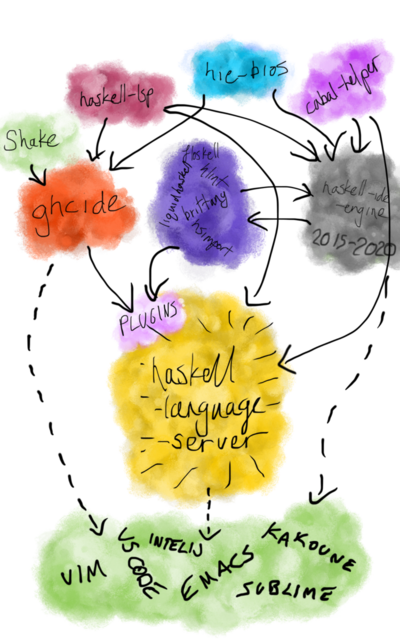The State of Haskell IDEs
Posted on May 8, 2020 by Luke Lau

It is an exciting time for Haskell tooling. As many might be aware, the past year has seen a number of significant changes to the ecosystem, with one of the most noticeable ones being the marriage of ghcide and haskell-ide-engine. We now have contributors from both projects working towards a unified vision of a language server, the haskell-language-server, which aims to be the de-facto IDE for veteran and newcomer Haskellers alike: A full-fledged LSP server that provides diagnostics, code completion, navigation and more, works with both your Cabal and Stack projects, and scales from tiny scripts all the way up to huge codebases like GHC.
haskell-language-server does not do this on its own however. It builds upon a whole ecosystem of tools to drive all of the underlying IDE features. How they all interconnect can be a bit overwhelming at first, so this post will break it down and take a look at them individually.

ghcide
Powering the language server under the hood is ghcide. Based on tooling built for DAML, it is the core piece of infrastructure that talks to GHC to parse and typecheck your code. One of its many clever innovations is the use of the Shake build system to keep an in-memory cache of modules, file contents and other computations (e.g. code completions). Tooling built on top of it can then query it to get responsive, up-to-date information about the code it is working with. ghcide is also a language server itself, so if you need a lightweight IDE without any fancy trimmings then it will slot right in with any LSP client.
hie-bios
In order for ghcide to set up the GHC session, it needs to know what set of flags to pass to it. Unfortunately, this is not just as simple as -Wall -O1 — if you ever run cabal build -v you will find that there are loads of flags passed to GHC, a lot of them related to whatever packages your project depends on. hie-bios takes care of this by querying the underlying build tool, such as Stack, Cabal or Hadrian, delegating it the work of figuring out the flags and building any package dependencies that might be needed. By specifying a hie.yaml file in your project’s root directory, you can specify one or more cradles, where each cradle represents some component to build with a specific build tool.
cabal-helper
You can leave out the hie.yaml file, and hie-bios will try its best to infer which components to build with which tools. However this can get fairly complicated and hairy quickly. haskell-ide-engine and haskell-language-server use cabal-helper to query more information about your project to help with this.
haskell-lsp
haskell-lsp provides the transport between the client and the server using the Language Server Protocol. It keeps track of a lot of bookkeeping within the protocol, like request IDs and client/server capabilities, and also provides a virtual file system that mirrors edits coming in from the text editor, before they have saved the actually document. Having this mirror is pretty useful for external tools that need to be run on physical files rather than in-memory text buffers. Its sister library, haskell-lsp-types, provides type definitions for the actual specification, so if you want to do your own thing you don’t need to rewrite the data types and parsing all over again.
lsp-test
lsp-test is a testing framework for LSP servers, used by ghcide, HIE and haskell-language-server. It acts as a language client that can be programmed to send messages to servers, and assert that the right messages are received back. It can also be used to recreate certain scenarios: useful for hunting down memory leaks.
GHC .hie files
A lot of the work on ghcide and haskell-ide-engine has driven new features and functionality upstream into GHC. One such example is .hie files. These are generated with the -fwrite-ide-flag during compilation, and like a .hi file they contain additional information about some compiled module. However .hie files contain lots of information specifically useful for tooling, such as the type of expressions or where things are defined, hence the acronym for haskell information extended — not to be confused with haskell-ide-engine! Work is underway to use these files in ghcide to provide much more accurate code navigation, completion and type definitions.
haskell-ide-engine
The haskell-ide-engine is a language server that faithfully served as a focal point for a whole suite of tools. It’s been a relatively long-running project: It predates the existence of LSP! It originally used ghc-mod as its backend before switching to hie-bios, and it provides a bunch of logic for extracting code completion and symbols etc. out of the GHC API that eventually got absorbed into ghcide. It also has a plugin system which allows external tools to easily interface with LSP. So built into HIE, Floskell, Ormolu and Brittany can provide formatting whilst GHC, Liquid Haskell and HLint provide diagnostics, all through the same interface.
haskell-language-server
haskell-language-server now aims to concentrate the efforts behind ghcide and haskell-ide-engine. It uses the powerful core of ghcide and HIE’s approach of plugins to integrate an ecosystem worth of tools. Eventually there will be enough tools integrated that users will be able to configure what tools they want to use for each job. Floskell for formatting, or Ormolu? And more importantly, because it builds upon so many components, haskell-language-server will receive any improvements made downstream. This division of labour allows contributors to focus on the individual problems that need tackled, whilst benefiting the whole ecosystem.
Ultimately this means that haskell-ide-engine is being sunset and users should eventually move to haskell-language-server when it is ready. ghcide will continue to be developed and will serve as the underlying backend that powers haskell-language-server.
Looking forward
We are now entering the renaissance of Haskell tooling. This summer there are 3 Google Summer of Code projects and a Tweag open source fellowship all working on tooling, as well as the continued efforts of many contributors.
Fendor is working on supporting compilation of multiple home-packages at once within GHC. In short this will allow tooling to work with multiple components inside a package simultaneously. Luke Lau (that’s me) is improving the implicit discovery of cradles in hie-bios by connecting together the Cabal show-build-info command, which will give a much more reliable Cabal setup in the absence of hie.yaml files. Zubin Duggal will be focusing on the haskell-language-server, fleshing out its features and taking advantage of GHC’s .hie files. And Michalis Pardalos is integrating OpenTelemetry with the language servers, so that we can instrument and profile how they perform on the vast heterogeneous array of LSP clients that they may be used with.
By the end of the summer we will have built a robust language server which works on any Haskell project of any size and built with any build system.
There are a lot of exciting projects in the pipeline, and we will be posting about them here every Friday. In the meantime, come chat with us over at #haskell-ide-engine on Freenode, clone some projects and help us build the ultimate Haskell IDE.
Index
 IDE
IDE